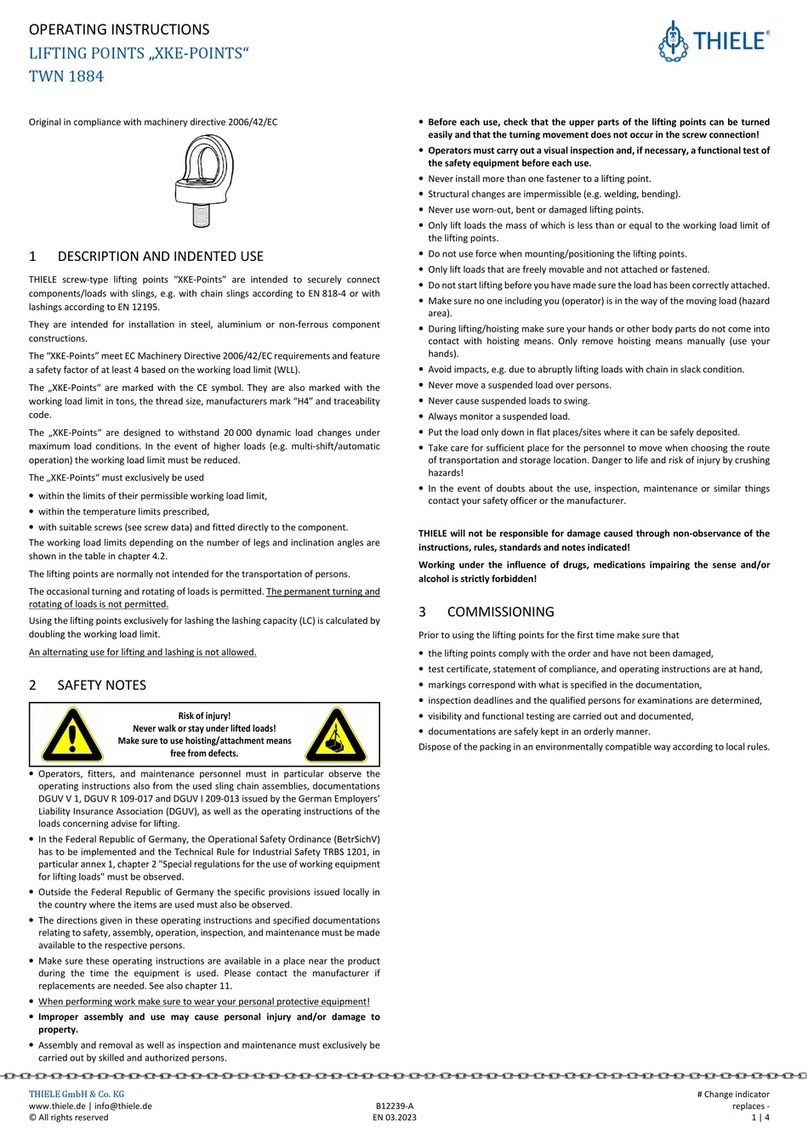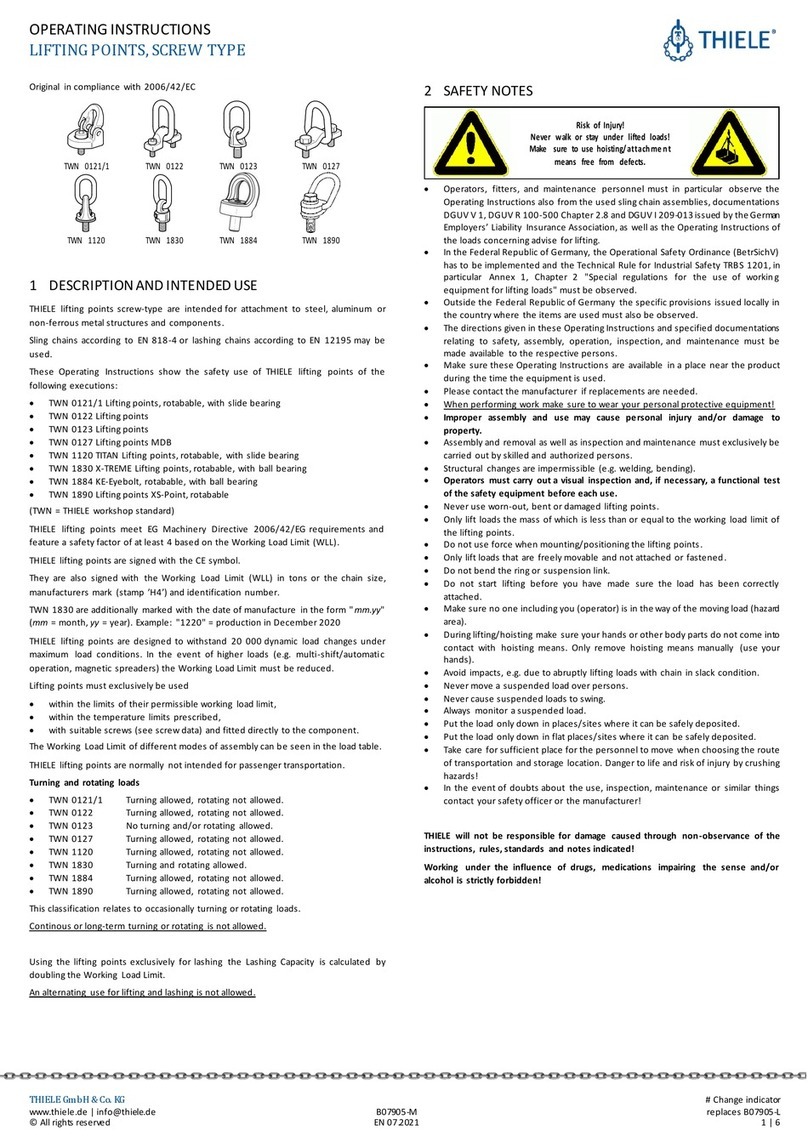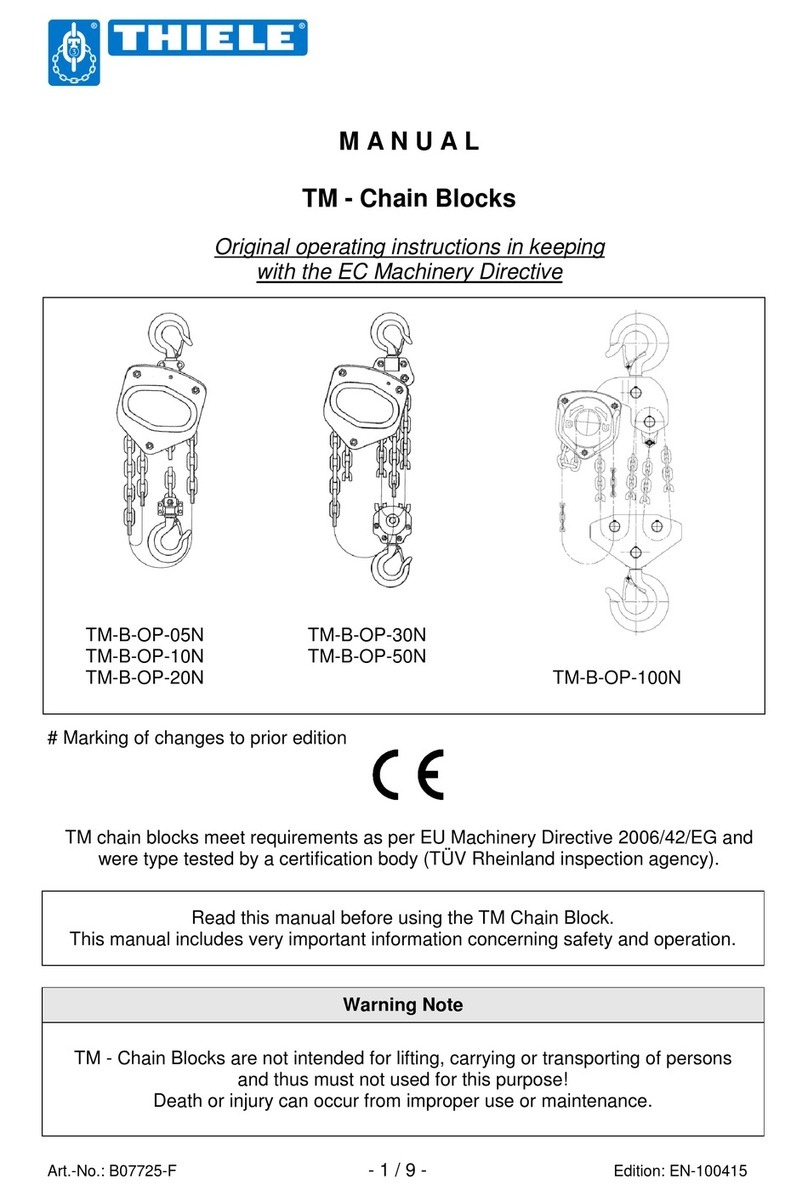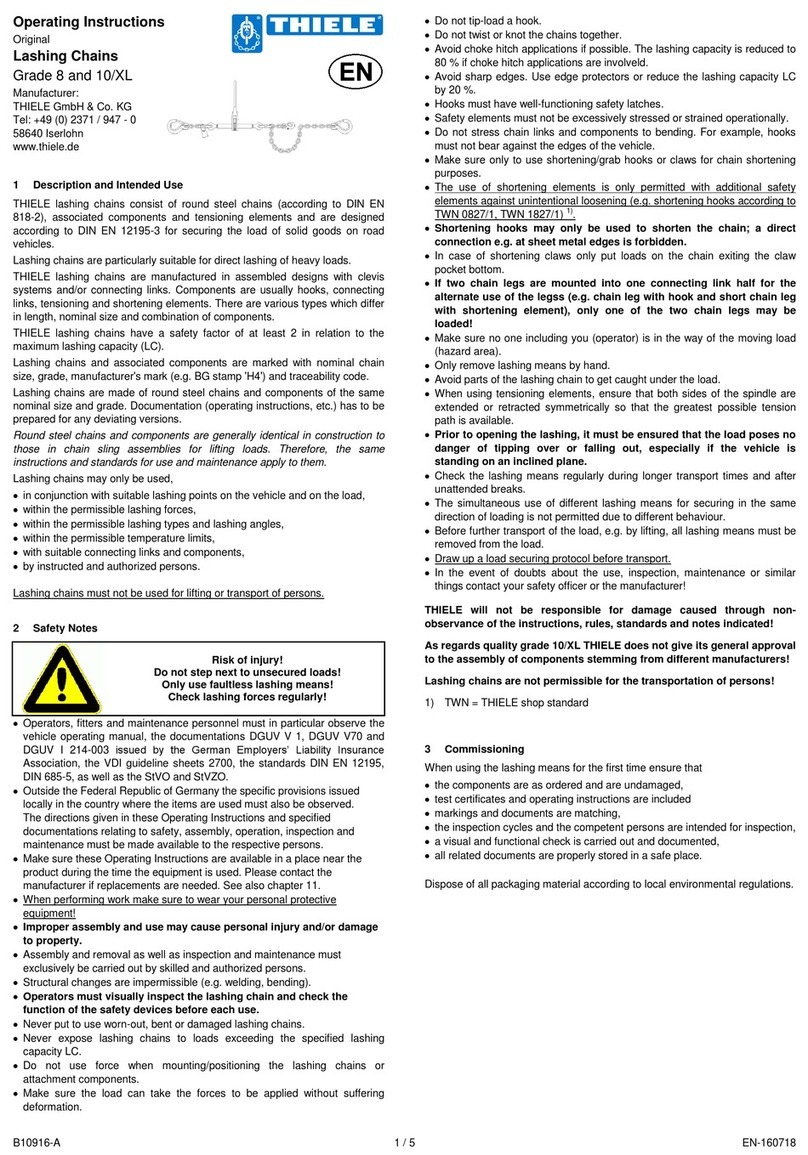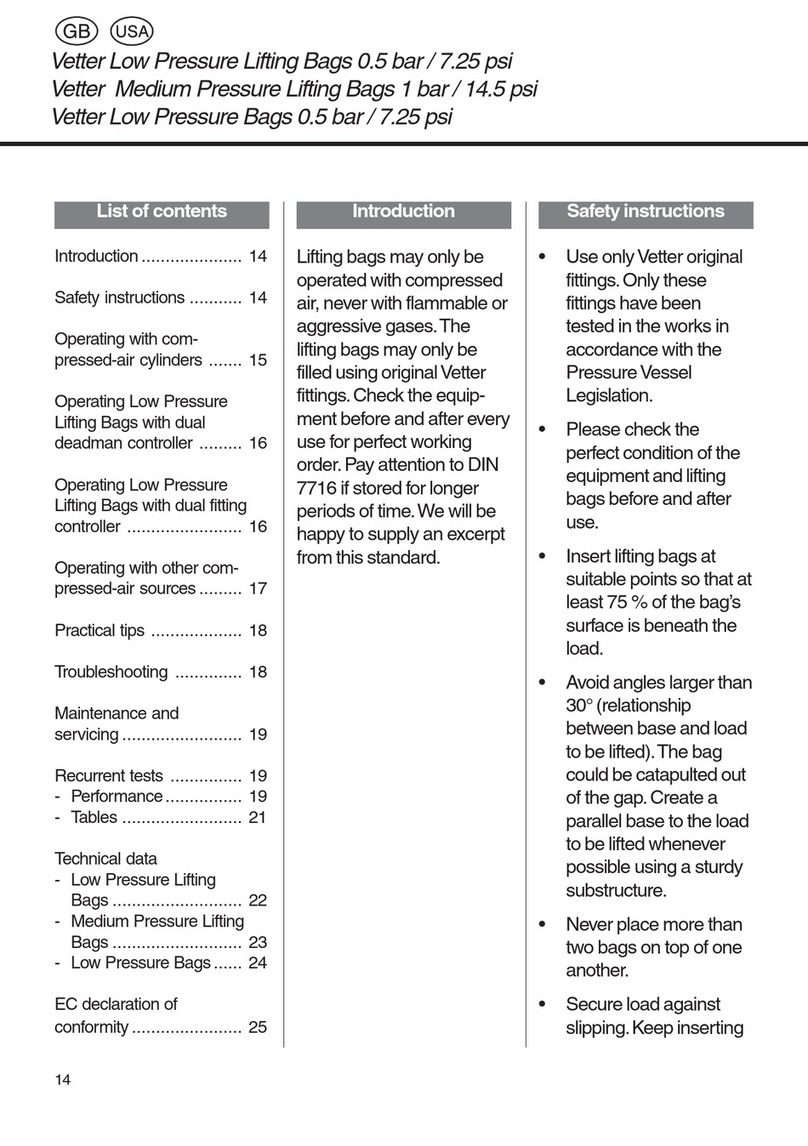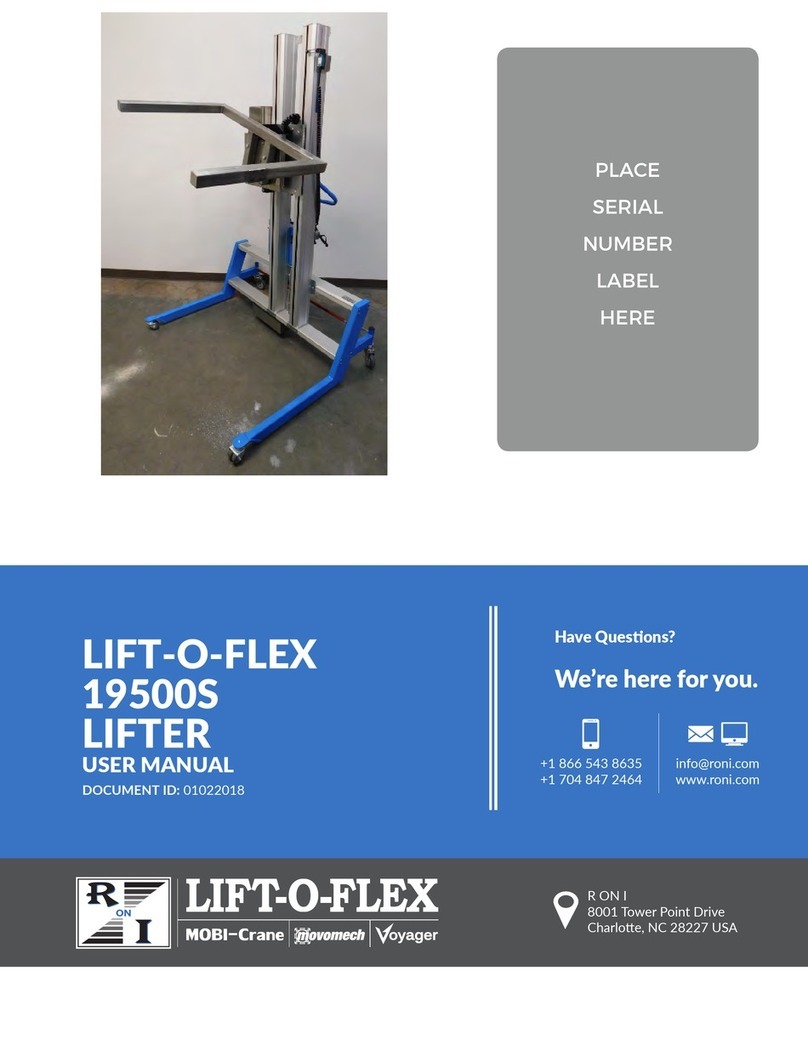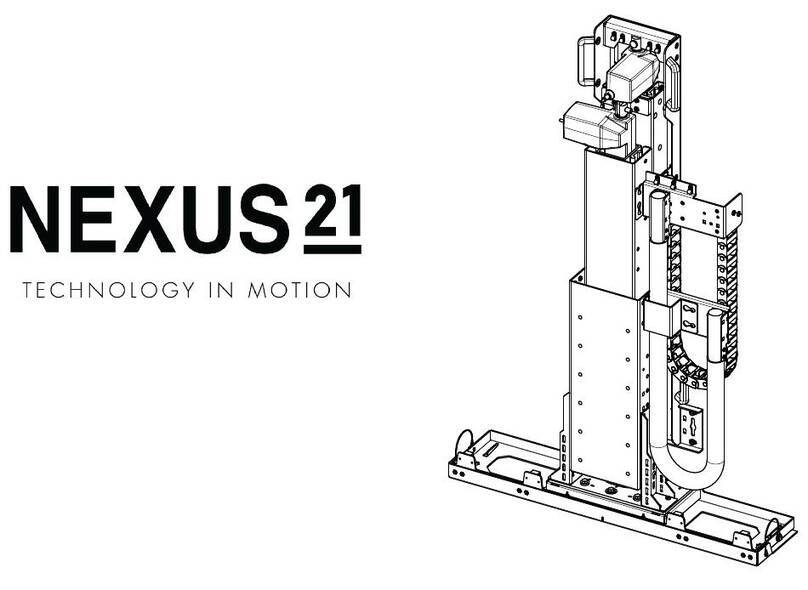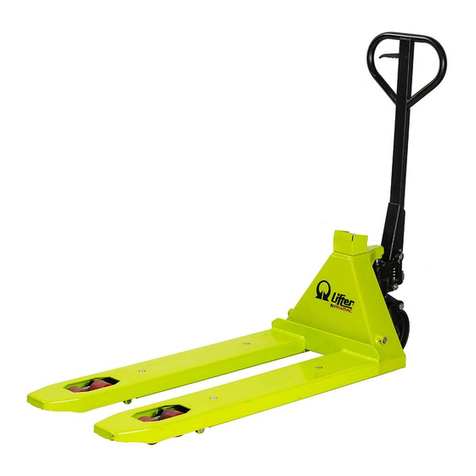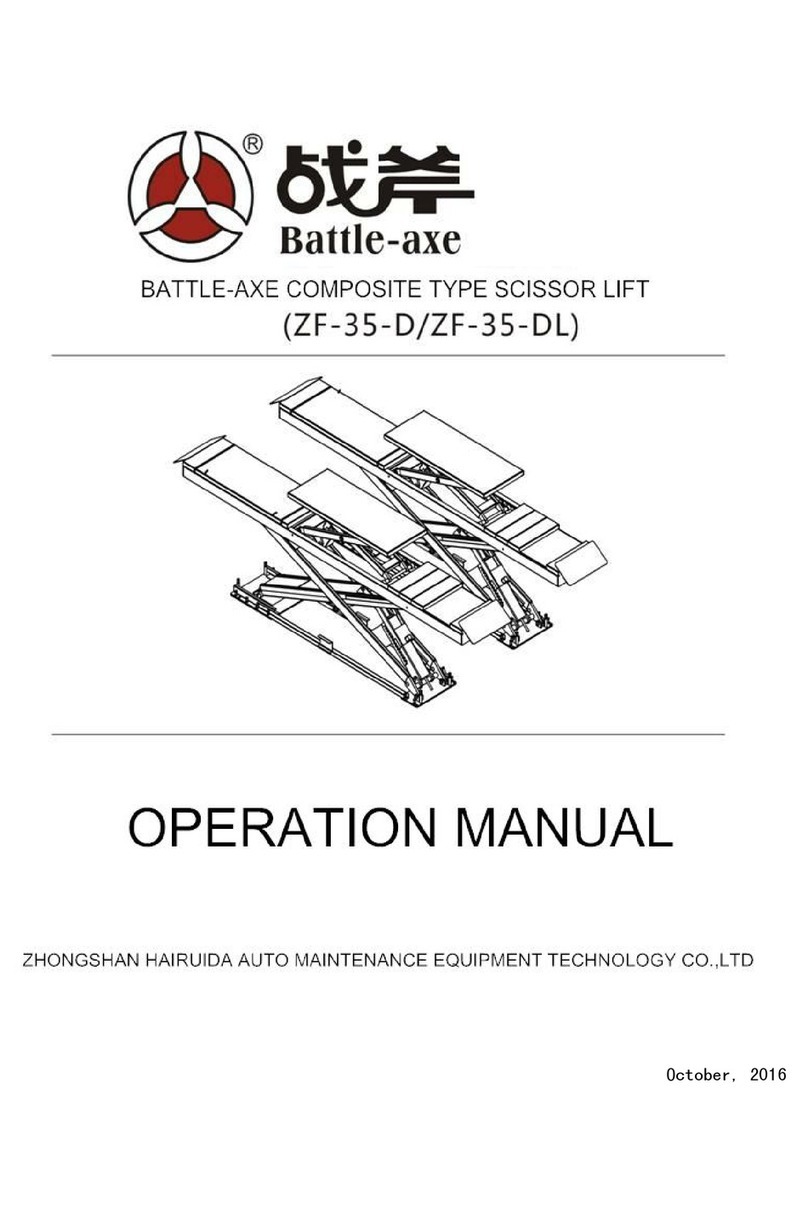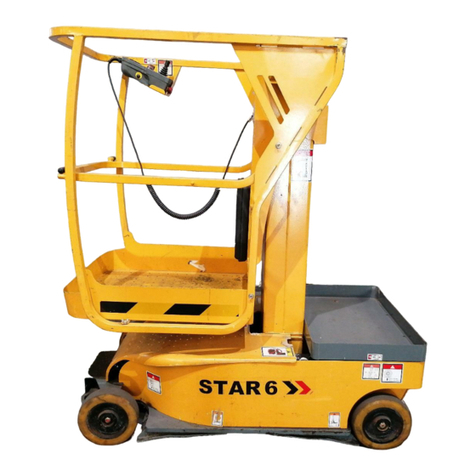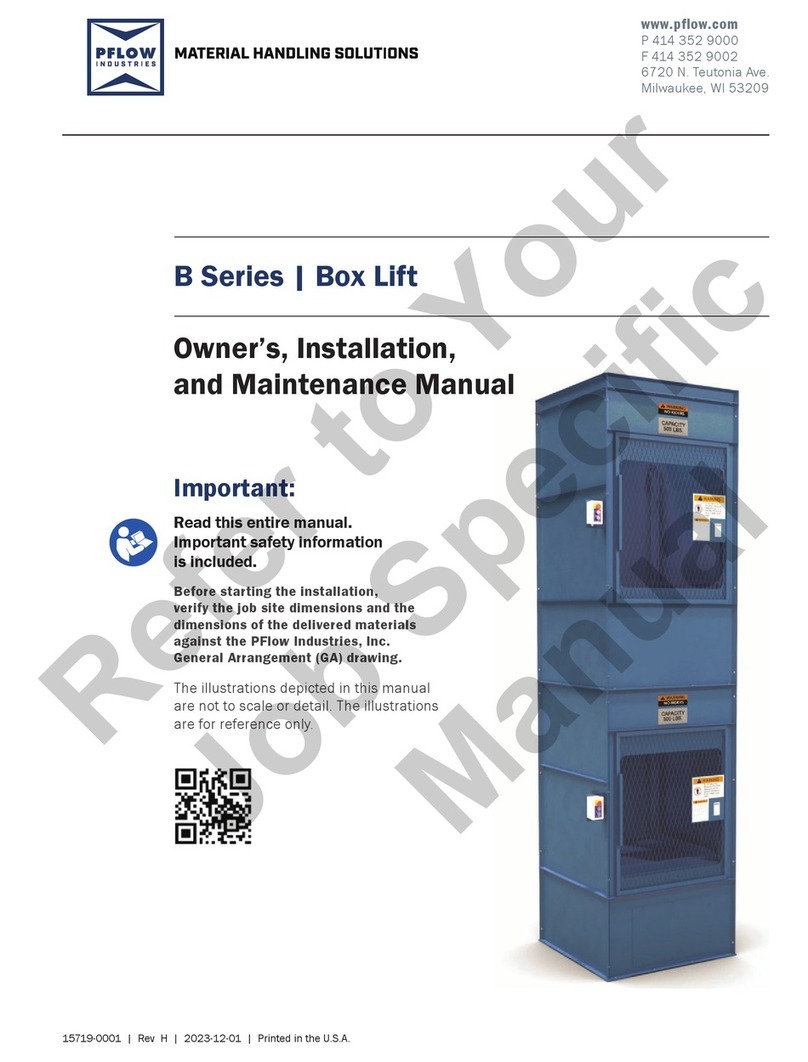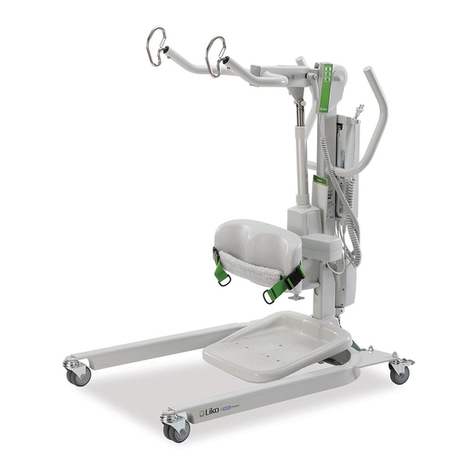Thiele TWN 1884 User manual

OPERATING INSTRUCTIONS
LIFTING POINTS “XKE-POINTS”
TWN 1884
THIELE GmbH & Co. KG # change indicator
www.thiele.de | info@thiele.de 12243-A replaces -
© All rights reserved US 03.2023 1 | 6
The following operating instructions must always be
followed to avoid the risk of personal injury or property
damage.
Do not use a lifting point “XKE Point” before reading these
operating instructions.
1. A OUT THIS INSTRUCTION
These operating instructions describe in particular how screw
type lifting points “XKE-Points” according to TWN 1884 (TWN =
THIELE Shop Standard) are to be safely used for lifting purposes.
To comply with these instructions is essential to help avoiding
hazards and increases the reliability and service life of the lifting
points.
DANGER! Indicates a hazardous
situation, which, if not avoided, will
result in death or serious injury.
WARNING! Indicates a hazardous
situation, which, if not avoided, could
result in death or serious injury.
CAUTION! Indicates a hazardous
situation, which, if not avoided, could
result in minor or moderate injury.
NOTICE! Is used to address practices
not related to physical injury.
SAFETY INSTRUCTIONS signs indicate
specific safety-related instructions or
procedures.
Definitions
Working Load Limit (WLL)
The maximum load, which a lifting point is designed to support.
Read ASME B30.9 for sling inspection criteria.
Read ASME B30.26 “Rigging Hardware”,
Chapters 26 0, 26 1, 26 4.
2. ASIC SAFETY REQUIREMENTS
To prevent the risk of injury never walk or stay under lifted
loads!
The working load limit must not be exceeded!
Lifting points as well as lifting and attachment means to be
used must be free from defects!
Working under the influence of drugs, medications
impairing the sense and/or alcohol is strictly forbidden!
•Operators, fitters and maintenance personnel must in
particular observe the operating instructions of the used sling
assembly. The operating instructions for the load, if it
contains instructions for lifting, must also be observed.
•The specific safety and operating regulations and standards
issued locally in the country where the items are used must
be observed.
•The directions given in these operating instructions and
specified documentations relating to safety, assembly,
operation, inspection, and maintenance must be made
available to persons operating and using the lifting points.
•These operating instructions must be available in a place near
the product during the time the equipment is used. Please
contact the manufacturer if replacements are needed. See
also chapter 12.
•During operation work, wear your personal protective
equipment!
•Improper assembly and use may cause personal injury
and/or damage to property.
•Assembly and removal as well as inspections and
maintenance must exclusively be carried out by skilled,
qualified, trained and authorized persons only.
•Before each use, check that the upper parts of the lifting
points can be turned easily and that the turning movement
does not occur in the screw connection!
•Operators must carry out a visual inspection and, if
necessary, a functional test of the safety equipment before
each use.

OPERATING INSTRUCTIONS
LIFTING POINTS “XKE-POINTS”
TWN 1884
THIELE GmbH & Co. KG # change indicator
www.thiele.de | info@thiele.de 12243-A replaces -
© All rights reserved US 03.2023 2 | 6
•Never install more than one connecting component to a ring.
•Structural changes are impermissible (e.g. welding, bending).
•Never use worn-out, bent or damaged lifting points.
•Only lift loads that do not exceed the working load limit of the
lifting points.
•In case of using a 3- or 4-leg chain sling, never allow for
inclination angles of less than 30° and in excess of 75°.
•Do not use force when mounting/positioning the attachment
components.
•Only lift loads that are freely movable and not attached or
fastened.
•Do not start lifting before you have made sure the load has
been correctly attached and balanced.
•No one including you (operator) must be in the way of the
moving load (hazard area).
•During lifting your hands or other body parts must not come
into contact with lifting means. Only remove lifting means
manually (use your hands).
•Avoid impacts, e.g. due to abruptly lifting loads with chain in
slack condition.
•Never move a suspended load over persons.
•Never cause suspended loads to swing.
•Always monitor a suspended load.
•Put the load only down in flat places/sites where it can be
safely deposited.
•Assume for sufficient place for the personnel to move when
choosing the route of transportation and storage location.
Danger to life and risk of injury by crushing hazards!
•In the event of doubts or concerns about the proper and safe
use, inspection, maintenance or similar things contact your
safety officer or the manufacturer.
THIELE is not responsible for damage caused by non observance
of the instructions, rules, standards and notes indicated!
As a rule, lifting points are not permitted for the transportation
of persons.
3. DESCRIPTION AND INTENDED USE
THIELE lifting points “XKE-Points” are intended to securely
connect components/loads with slings, e.g. with chain slings
according to ASTM A 906/A 906 M.
They are intended for installation to steel, aluminum or non-
errous metal component structures.
THIELE lifting points “XKE-Points” meet EC Machinery Directive
2006/42/EC requirements and feature a safety factor of at least
4 based on working load limit.
They are signed with the working load limit in tons, the thread
size, manufacturer’s mark “H4” and traceability code.
THIELE lifting points “XKE-Point” are designed to withstand
20 000 dynamic load changes under maximum load conditions.
In the event of higher loads (e.g. multi-shift/automatic operation)
the working load limit must be reduced.
The “XKE-Points” must exclusively be used
•within the limits of their permissible working load limit,
•within the temperature limits prescribed,
•with suitable screws and fitted directly to the component.
The working load limits depending on the number of legs and
inclination angles are shown in the table in chapter 5.2.
Using the lifting points exclusively for lashing, the lashing capacity
(LC) is calculated by doubling the working load limit.
The occasional turning and rotating of loads is permitted.
The permanent turning and rotating of loads is not permitted.
An alternating use for lifting and lashing is not allowed.
4. COMMISSIONING
Prior to using the components for the first time assure that
•the components comply with the order and have not been
damaged,
•test certificates and operating instructions are at hand,
•markings correspond with what is specified in the
documentation,
•inspection deadlines and the qualified persons for
examinations are determined,
•visibility and functional testings are carried out and
documented,
•documentation is safely kept in an orderly manner.
Dispose of the packing in an environmentally compatible way
according to local rule.

OPERATING INSTRUCTIONS
LIFTING POINTS “XKE-POINTS”
TWN 1884
THIELE GmbH & Co. KG # change indicator
www.thiele.de | info@thiele.de 12243-A replaces -
© All rights reserved US 03.2023 3 | 6
5. TECHNICAL DATA
5.1 Dime sio s
Thread
size
Working load
limit (WLL) Article no.
Dimensions [mm] Tightening
torque
1)
Mass
dg [mm]
[t] b c2 c3
e
f
h lg
d1
d2
l SW
[Nm] [kg]
M 8 0,3 F38005 26
45 37 40 26
50 16
9,5
9,5
8 6 13 0,18
M 10 0,5 F38006 26
45 37 40 26
50 16
9,5
9,5
8 6 25 0,18
M 12 1,0 F38007 30
51 43 47 30
57 18
11
11
10
8 40 0,29
M 16 1,7 F38010 38
66 56 62 38
76 27
14
14
13
10 90 0,66
M 20 2,6 F38020 42
74 61 70 42
86 33
16
16
15
12 170 0,99
M 24 3,5 F38030 51
85 65 82 51
99 39
17
18
16
14 280 1,34
M 30 6,0 F38040 62
104
82 97 62
118
45
21
22
20
19 550 2,29
M 36 8,0 F38050 75
131
92 116
75
144
55
28
28
25
19 900 4,18
M 42 12,5
F38060 95
173
122
142
95
181
64
39
39
33
22 1 400 8,89
M 45 15,0
F38070 95
173
122
142
95
181
74
39
39
33
24 1 600 9,12
M 48 17,0
F38080 95
173
122
142
95
181
74
39
39
33
27 1 900 9,21
1) See chapter 5.2
5.2 Worki g load limit (WLL) depe di g o umber of legs (lifti g poi ts) a d i cli atio a gle
Attachment type
Number of legs 1 Leg 2 Legs 1 Leg 2 Legs 2 Legs 2 Legs 3 /4 Legs 3 /4 Legs
Inclination angle α
90°
±5°
90°
±5°
90°
±5°
90°
±5°
45° 90°
30° 45° asym.
2)
45° 90°
30° 45° asym.
2)
WLL
[t]
Thread
[mm] MAXIMUM TOTAL LOAD [t]
3)
0,3 M 8 0,3 0,6 0,3 0,6 0,4 0,3 0,3 0,6 0,45 0,3
0,5 M 10 0,5 1,0 0,5 1,0 0,7 0,5 0,5 1,0 0,75 0,5
1,0 M 12 1,0 2,0 1,0
2,0
1,4 1,0
1,0
2,1 1,5 1,0
1,7 M 16 1,7 3,4 1,7 3,4 2,4 1,7 1,7 3,6 2,5 1,7
2,6 M 20 2,6 5,2 2,6 5,2 3,6 2,6 2,6 5,5 3,9 2,6
3,5 M 24 3,5 7,0 3,5 7,0 4,9 3,5 3,5 7,4 5,2 3,5
6,0 M 30 6,0 12,0 6,0 12,0 8,4 6,0 6,0 12,7 9,0 6,0
8,0 M 36 8,0 16,0 8,0 16,0 11,3 8,0 8,0 16,9 12,0 8,0
11,5 M 42 11,5 23,0 11,5 23,0 16,2 11,5 11,5 24,3 17,2 11,5
13,0 M 45 13,0 26,0 13,0 26,0 18,3 13,0 13,0 27,5 19,5 13,0
14,5 M 48 14,5 29,0 14,5 29,0 20,5 14,5 14,5 30,7 21,7 14,5
2) Reduced working load limits according to DIN 685-5
3) Without consideration of further slings

OPERATING INSTRUCTIONS
LIFTING POINTS “XKE-POINTS”
TWN 1884
THIELE GmbH & Co. KG # change indicator
www.thiele.de | info@thiele.de 12243-A replaces -
© All rights reserved US 03.2023 4 | 6
6. ASSEM LY AND REMOVAL
6.1 Preparatio s
All components to be installed or used must be in perfect
condition and the relevant working load limits of all parts must
accommodate the respective load to be handled.
The mounting location for each lifting point has to ensure that
•the load can take the forces including safety factors safely to
be applied without suffering deformation,
•the lifting point can be assembled flush,
•no areas of danger are created (crushing point, shearing
point),
•lifting and moving is not restrained by overhang,
•used lifting means (e.g. hooks) are freely movable and will
not be bended,
•incorrect use is avoided,
•the sling cannot be damaged, for example by sharp edges,
•lifting point can be used easily.
6.2 Assembly
The useful depth of the thread must enable the lifting points to
be safely screwed in. Use only the delivered screws!
The threaded hole must be perpendicular to the screw-on
surface in the load. The depth of the thread "L" of the
component must be at least as follows:
L = 1.0 x d for steel (yield stress R
e
≥ 235 N/mm²)
L = 1.25 x d for castings
L = 2.0 x d for aluminum
L = 2.5 x d in aluminum-magnesium-alloys
(L = depth of thread; d = thread diameter)
•Make sure the threads of the lifting point and in the
component are clean and dry.
•For lifting points have to remain on the component a usual
fluid safety agent for screws has to be used.
•For through-boltings, the nut must be secured against
loosening.
•Single lifting operation WITHOUT turning or rotating:
Hand-tighten the screws with a suitable spanner for screws
with hexagon socket according to DIN.
It must be ensured that the screws of the lifting points
cannot loosen by themselves.
•Lifting WITH turning or rotating as well as multiple lifting
operations:
Tighten the screws to the tightening torques specified in the
technical data.
However, repeated lowering of the load to the ground
requires a new check!
Lifting points that remain on the loads should be tightened
to the tightening torques specified in the technical data.
•Chamfers on the threaded holes are not required.
6.3 Removal
Unload the lifting point and remove any lifting attachments
connected to it. Turn the screw counterclockwise and remove
the lifting point. Assure that no damage occurs during transport
and storage.
7. CONDITIONS OF USE
Continuous or long term turning or rotating is not
allowed.
An alternating use for lifting and lashing is not allowed.
7.1 Normal use
The working load limit for different applications of assembly can
be seen in the load table, chapter 5.2.
The force must be applied in the longitudinal direction of the
attached component (e.g. hook).
The attached component (e.g. hook) must always be able to
move freely. Supporting the component at the lifting point is not
permissible.
Using 4-leg chain sling assemblies may cause higher risk because
only two opposite legs may carry the load. Check the working
load limit of lifting points and chain sling assembly carefully and
chose if necessary bigger sizes.
The following illustrations show typical applications and
foreseeable misuse:

OPERATING INSTRUCTIONS
LIFTING POINTS “XKE-POINTS”
TWN 1884
THIELE GmbH & Co. KG # change indicator
www.thiele.de | info@thiele.de 12243-A replaces -
© All rights reserved US 03.2023 5 | 6
7.2 Use i through holes
If lifting points are fastened by means of nuts in holes (e.g. of
metal sheets), the following conditions must be observed:
•Turning or rotating the load is not permitted.
•The strength class of the nuts must be 10 or higher (thread
size M12: class 12).
•The chamfer at the end of the screw thread must protrude
from the nut.
•It must be ensured that the component to be lifted is suitable
to withstand the force to be applied safely and without
deformation, including the corresponding safety factors.
•Suitable action must be taken to ensure that the nut cannot
loosen unintentionally, e.g. suitable torque or threadlocker.
7.3 I flue ce of temperature
The permissible working load limit of the lifting points reduces
at elevated temperatures. The reduced working load limit
figures shown in the following tables shall only apply for short-
term use at the temperatures indicated.
Temperature range Remaining WLL
-20 °C ≤ t ≤ 100 °C
- 4 °F ≤ t ≤ 212 °F 100 %
100 °C < t ≤ 205 °C
212 °F ≤ t ≤ 400 °F 85 %
205 °C < t ≤ 250 °C
400 °F ≤ t ≤ 482 °F 80 %
250 °C < t ≤ 300 °C
482 °F ≤ t ≤ 572 °F 75 %
Take care for a loss of lubricant depending on several fitting
positions and higher temperatures. A higher wear may occur.
Shorten the inspection interval for that case.
7.4 E viro me tal i flue ce
Lifting points must not be used in environments where acids,
aggressive or corrosive chemicals or their fumes are present.
Hot-dip galvanizing or a galvanic treatment is also prohibited.
7.5 Especially hazardous co ditio s
The degree of danger when used in offshore applications, the
lifting of hazardous loads, such as for example liquid metal or
similar, risk potentials have to be assessed by a competent
person in the form of a risk analysis. Any additional rules and
directives must be followed in this case.
8. INSPECTION, MAINTENANCE, DISPOSAL
8.1 Ge eral
Inspections and maintenance must be arranged by the owner!
Inspection deadlines shall be determined by the owner!
Visual inspections must be carried out and documented by
competent and trained persons regularly but at least once a
year, or more frequently if the lifting points are in heavy-duty
service. After three years at the latest, they must additionally be
examined for cracks. A load test is not a substitute for this
examination.
The results of the inspection shall be kept in a file that has to be
set up for each lifting point before first use. The register will
show characteristic data as well as identity details.
Immediately stop using lifting points that show the following
defects:
•missing or illegible identification/marking
•deformation, elongation or fractures
•cuts, notches, cracks, incipient cracks, pinching
•limited rotatability (dry or stuck ball bearing)
•heating beyond permissible limits
•severe corrosion
•defect screw or thread
8.2 I spectio
service
THIELE offers inspection, maintenance and repair services for
lifting points performed by trained and competent personnel.
8.3 Mai te a ce
Maintenance and repair work must only be performed by
competent and trained persons.
Minor notches and cracks at suspension links may be eliminated
by careful grinding observing the maximum cross section
reduction requirement of 10 % and avoid making more severe
cuts or scores.
Regreasing of the ball bearing is not intended. Replace lifting
points with recognisably dry ball bearings.
All maintenance and repair activities are to be documented.
8.4 Disposal
All components and accessories of steel taken out of service
must be scrapped in accordance with local regulations and
provisions.
If a lifting point has been exposed to temperatures
exceeding the maximum value specified, it must not be
used furthermore.
Use below 40 °F / 40 °C is generally not permitted.

OPERATING INSTRUCTIONS
LIFTING POINTS “XKE-POINTS”
TWN 1884
THIELE GmbH & Co. KG # change indicator
www.thiele.de | info@thiele.de 12243-A replaces -
© All rights reserved US 03.2023 6 | 6
9. SPARE PARTS
Use only original spare parts.
Exclusively use original THIELE screws because these are made
to meet special requirements e.g. concerning the impact
toughness.
Thread size
Article no. Screw data
M 8 Z11727 DIN 7991 M8 x 30 10.9
M 10 Z11728 DIN 7991 M10 x 30 10.9
M 12 Z11681 DIN 7991 M12 x 35 12.9
M 16 Z10869 DIN 7991 M16 x 50 10.9
M 20 Z11200 DIN 7991 M20 x 60 10.9
M 24 Z11199 DIN 7991 M24 x 70 10.9
M 30 Z11722 DIN 7991 M30 x 80 10.9
M 36 Z11747 DIN 7991 M36 x 100 10.9
M 42 Z11804 DIN 7991 M42 x 110 10.9
M 45 Z11805 DIN 7991 M45 x 120 10.9
M 48 Z11806 DIN 7991 M48 x 120 10.9
10. USE OF THIRD-PARTY SCREWS
If local circumstances dictate that screws have to be used
different from those supplied with the installation or listed in
chapter 9, the operator must ensure that
•these fasteners conform to the specified diameter and
strength class,
•they can achieve the minimum required screw-in depth,
•they are 100 % crack tested,
•each bolt has a proven notch impact energy of min. 36 J as a
mean value of three samples tested at -4 °F or at the lowest
fitting temperature if this is below -4 °F, and that none of the
samples fall below 25 J,
•written confirmation of the crack test and impact energy
results is enclosed with the technical documentation.
11. STORAGE
Lifting points must to be properly stored in dry conditions at
temperatures between 32 °F and 104 °F.
Do not store in a manner that cause mechanical damage.
12. THIELE OPERATING AND MOUNTING
INSTRUCTIONS
Current mounting and operating instructions are available as a
PDF download on the homepage.
13. PU LISHING INFORMATION
Company KWS Inc. THIELE GmbH & Co. KG
(Distributor) (Manufacturer)
Postal
address
P.O. ox 470487
Tulsa, OK 74147
USA
Werkstrasse 3
58640 Iserlohn
Germany
Phone
number +1 (539) 367 2274 +49 2371/947-0
Fax number +1 (539) 367 2278 +49 2371/947-241
Other manuals for TWN 1884
1
Table of contents
Other Thiele Lifting System manuals
Popular Lifting System manuals by other brands
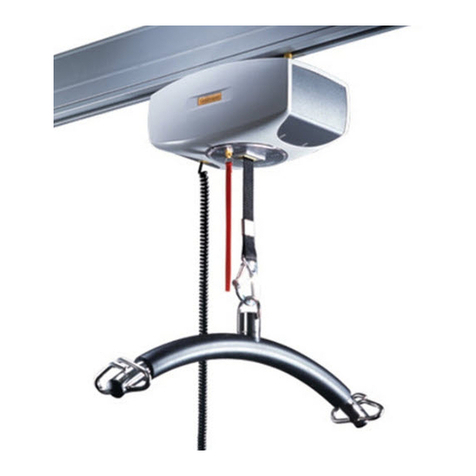
Guldmann
Guldmann GH2 installation guide
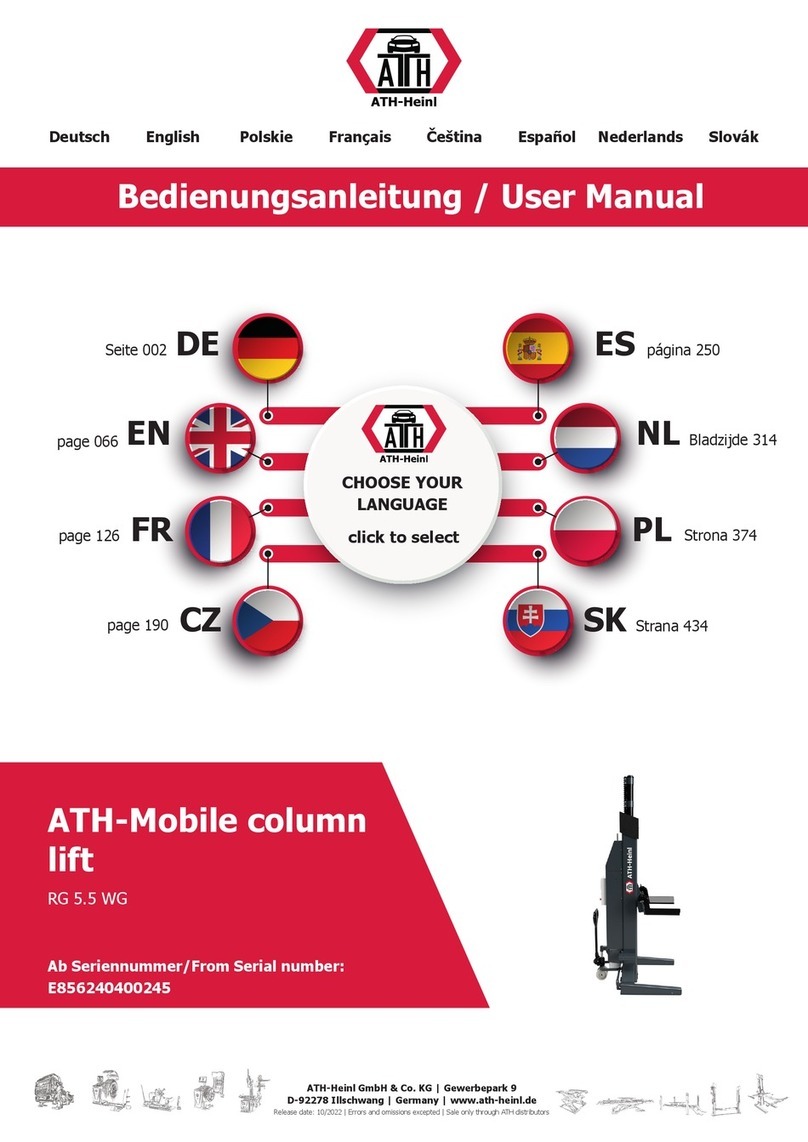
ATH-Heinl
ATH-Heinl RG 5.5 WG user manual
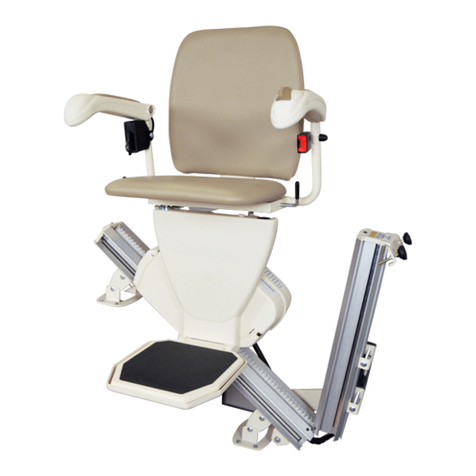
Harmar Mobility
Harmar Mobility Pinnacle SL600 Installation & service manual

Lehner Lifttechnik
Lehner Lifttechnik Delphin Manual and Operating Instruction

ASE
ASE 2000 owner's manual
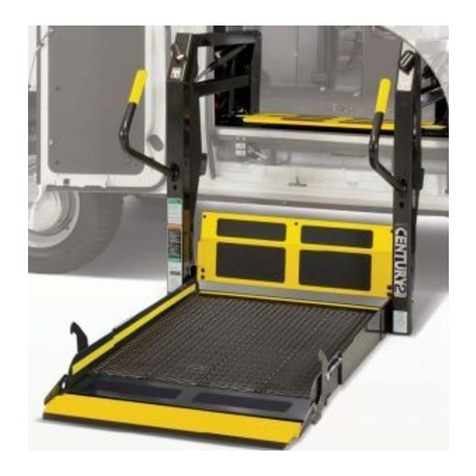
Braun
Braun VISTA Series Installation & service manual
